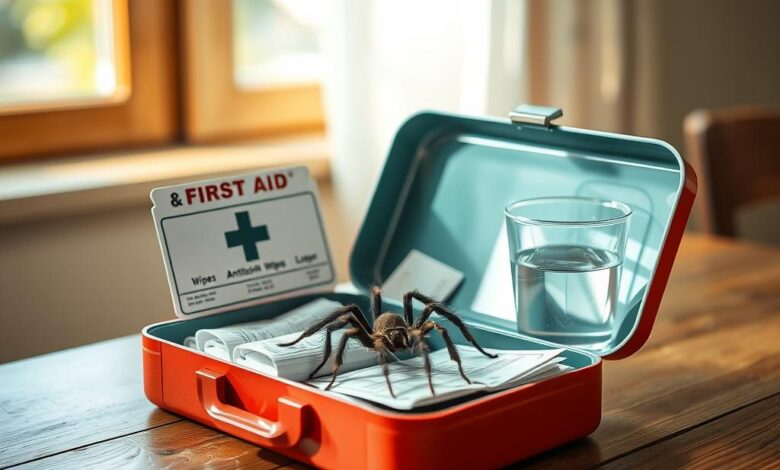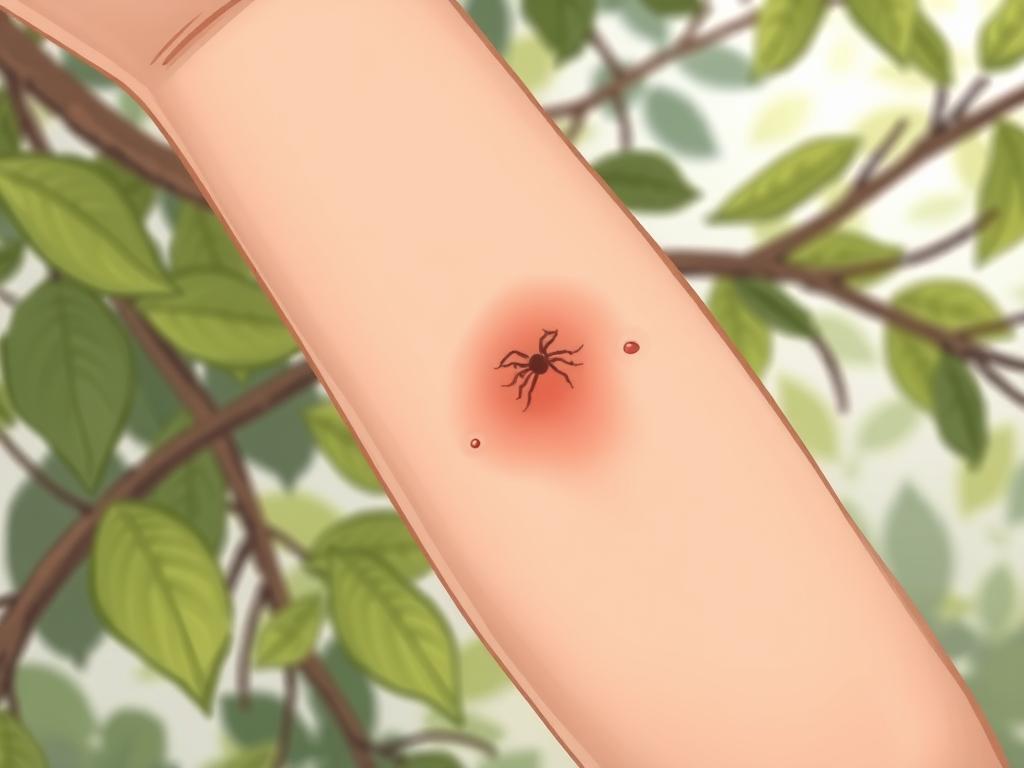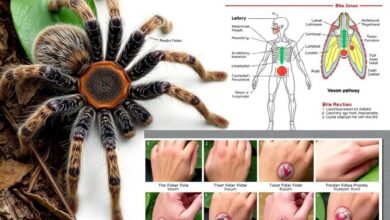Initial Home Treatment for Tarantula Bites

Ever wondered what to do if a tarantula bites you? It might seem scary, but you can handle many bites at home with the right first aid. We’ll look at home remedies and tell you when to get medical help for tarantula bites.
Tarantula bites can be scary, but knowing what to do can help you stay calm. We’ll talk about cleaning the wound, using cold compresses, and taking over-the-counter pain meds. We’ll also cover how to spot venomous tarantulas, prevent bites, and know when to get medical help right away.
Understanding Tarantula Bite Symptoms
Getting bitten by a tarantula can be scary, but knowing what might happen is key. The symptoms can vary based on the tarantula type and how you react to the venom.
Swelling and Redness at the Bite Site
Swelling and redness at the bite spot are common signs of a tarantula bite. This happens as your body fights off the venom. How much swelling and redness you see can differ, from mild to quite noticeable.
Muscle Cramps or Spasms
Some people might also feel muscle cramps or spasms from a tarantula bite. This is because the venom can mess with your muscles and nerves. These cramps can be painful and you should see a doctor if they get worse or don’t go away.
Knowing which tarantula species bit you helps in figuring out how to treat it. If you think you’ve been bitten, watch the symptoms closely. Get medical help if things get bad or if you’re worried.

Tarantula Bite Home Treatment
If you’re unlucky enough to get bitten by a tarantula, act fast. Quick steps can ease the pain, swelling, and discomfort. These simple home remedies can help.
Cleaning the Bite Area
Start by cleaning the bite area well. Use soap and warm water to wash it. This removes venom or debris and helps prevent infection. Make sure it dries before you do anything else.
 Using Antihistamines for Tarantula Bites
Using Antihistamines for Tarantula Bites
Applying Cold Compresses
Applying cold compresses can help with swelling and pain. Wrap ice cubes or a cold pack in a cloth. Hold it on the bite for 10-15 minutes, several times a day. Cold helps shrink blood vessels and lessen swelling.
Over-the-Counter Pain Medications
For pain and swelling, use over-the-counter pain meds like ibuprofen or acetaminophen. These can ease the discomfort. Just follow the dosage on the label.
These easy steps can help with a tarantula bite. They can manage symptoms and prevent more problems. Watch the bite for signs of infection or severe reactions. See a doctor if you need to.
Identifying Venomous Tarantula Species
Not all tarantula bites are the same in terms of danger. Knowing how to spot venomous tarantulas helps you know what to do next and if you need a doctor.
There are about 1,100 known species of tarantulas worldwide. Most of these spiders are harmless to humans. But, some have venom that can cause serious reactions. Learning about these dangerous species helps you stay safe.
Recognizing Venomous Tarantulas
Venomous tarantulas have certain looks that make them stand out. Here are some things to watch for:
- Bright, vibrant colors or patterns, such as red, orange, or yellow markings
- Larger size, with a body length of 3-5 inches or more
- Thick, powerful fangs capable of penetrating skin
- Aggressive behavior, such as rearing up, hissing, or striking when threatened
Some of the most dangerous tarantulas include the Poecilotheria (ornamental tree spiders) and Pterinochilus (African red baboon spiders). These spiders have very strong venom. You should be very careful around them.
| Venomous Tarantula Species | Venom Potency | Bite Symptoms |
|---|---|---|
| Poecilotheria spp. (Ornamental Tree Spiders) | Highly Venomous | Severe pain, swelling, and muscle spasms |
| Pterinochilus spp. (African Red Baboon Spiders) | Highly Venomous | Intense pain, nausea, and potential respiratory distress |
Knowing what venomous tarantulas look like helps you stay safe. If you get bitten, get medical help right away, especially if it’s from a dangerous species.
Preventing Tarantula Bites
Owning a tarantula is exciting and rewarding, but safety comes first. It’s key to follow spider bite prevention steps. Handle these spiders with care and respect their space to lower the bite risk. Using protective gloves and gentle handling is crucial when you’re with your tarantula.
 Managing Pain from Tarantula Bites
Managing Pain from Tarantula Bites
Handling Tarantulas with Caution
When you’re with a tarantula, be patient and move slowly. Quick moves or startling the spider might make it bite. Wear thick gloves to keep your hands safe, and support the spider’s body when you move it. Don’t grab or hold the tarantula down, as this can stress it out and make it more likely to bite.
Avoiding Disturbing Their Habitat
Tarantulas don’t like changes in their space, so be careful when handling tarantulas. Don’t open their enclosure or change their home often, as this can stress them. Keep a regular routine for your tarantula, and make sure it has places to hide and a comfy bed.
By being careful and respecting your tarantula’s needs, you can lower the risk of getting a spider bite. Putting your tarantula’s safety first makes owning one rewarding and fun.
When to Seek Medical Attention
Many tarantula bites can be treated at home. But, it’s important to go to the hospital if you see serious symptoms. These include severe reactions, allergic signs, or infection signs. These could lead to tarantula bite hospitalization if not treated.
Severe Reactions and Allergies
Some people may have severe tarantula bite reactions. This can include a lot of swelling, trouble breathing, or a fast heart rate. These signs might mean you’re having an allergic reaction. You should get medical help right away to avoid more problems.
Signs of Infection
- Persistent pain, redness, or swelling at the bite site
- Fever or chills
- Pus or drainage from the wound
- Swollen lymph nodes
These tarantula bite infection signs mean you need a doctor. They help stop serious infections from spreading.
Knowing these signs and getting medical help quickly is key. It makes sure you get the right treatment and avoids serious issues. Don’t wait to see a doctor if you’re worried about a tarantula bite.
Preparing for a Doctor’s Visit
If you get bitten by a tarantula and need medical help, being ready is key. You should know the time and place of the bite, the tarantula type (if you can tell), and any symptoms you see. Giving this info to doctors helps them know how to treat you, including possible tarantula bite medical treatment or tarantula venom antidote.
Be ready to tell the doctor about the tarantula bite symptoms you see, like swelling, redness, muscle cramps, or other issues. This helps doctors quickly figure out how serious your situation is and what care you need.
 When to Seek Medical Help after a Tarantula Bite
When to Seek Medical Help after a Tarantula Bite
Being prepared for your doctor’s visit helps you take charge of your health and recovery. It ensures any issues from the tarantula bite are handled well. This can make you feel more at ease and improve your chances of a good outcome.


